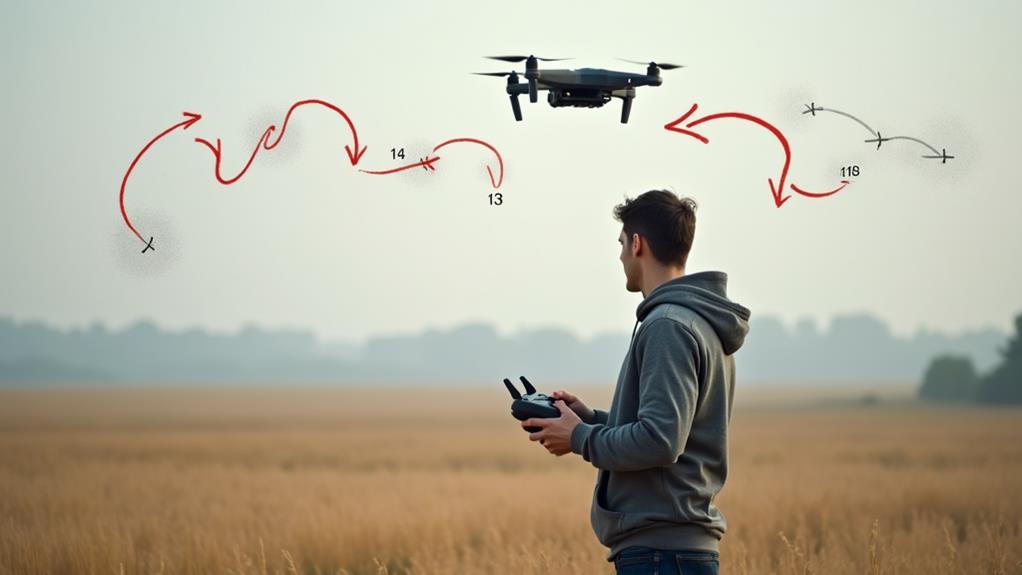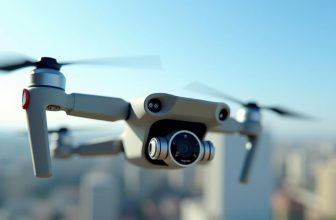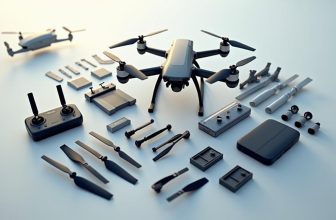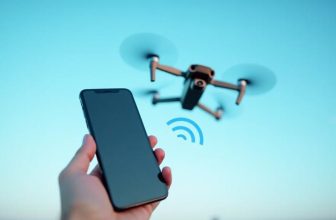
You're about to take the first step in becoming a skilled drone pilot. Unboxing and setting up your drone is just the beginning – it's vital to verify all components are present and undamaged. Familiarizing yourself with air traffic control rules and identifying safe operating zones will also help minimize risks. But before you initiate takeoff, there are several key steps to master. What are the essential pre-flight safety checks you need to conduct, and how do you stabilize the drone once it's airborne? Let's break it down, step by step, to guarantee a successful and safe flight experience.
Contents
Key Takeaways
- Conduct thorough pre-flight safety checks, including drone inspection and weather assessment.
- Familiarize yourself with air traffic control rules and safe drone operating zones.
- Choose the correct flight mode based on flying skills, environment, and mission objectives.
- Perform initial takeoff procedures, including final drone inspection and transmitter setup.
- Stabilize the drone by allowing its sensors to calibrate to the surrounding environment.
Unboxing and Initial Setup
Unboxing and Initial Setup
Carefully unpack the drone from its shipping box, guaranteeing all the components and accessories are included.
Verify the package contents against the manufacturer's documentation to confirm everything is present. This typically includes the drone itself, remote controller, batteries, propellers, and charging cables.
Perform a visual drone inspection to identify any damage or defects.
Check for dents, cracks, or scratches on the drone's body and propellers. Inspect the remote controller for any signs of damage or wear.
Next, charge the drone's batteries according to the manufacturer's instructions.
This may involve charging the batteries separately or using a charging hub. Read the user manual to understand the charging process and guarantee you're following the correct procedure.
Once the batteries are charged, proceed to assemble the drone by attaching the propellers to the motor mounts.
Make sure they're securely fastened to prevent them from coming loose during flight. Refer to the user manual for specific instructions on assembly and configuration.
Drone Safety Precautions
When flying a drone, you're not only responsible for operating the aircraft safely but also for adhering to regulations and respecting airspace.
As a drone operator, you must understand your responsibilities, including registering your drone if required and obtaining necessary permits.
You'll also need to familiarize yourself with air traffic control rules and identify safe drone operating zones to minimize the risk of accidents and guarantee a successful flight.
Drone Operator Responsibilities
In accordance with regulatory guidelines and industry best practices, you're expected to adhere to stringent safety protocols as a drone operator.
This includes obtaining operator certification through a recognized program, which involves passing an exhaustive exam that tests your knowledge of drone operations, safety procedures, and regulations.
The operator certification process typically involves both theoretical and practical training, guaranteeing you have the necessary skills to operate a drone safely and efficiently.
As a certified drone operator, you're also required to weigh drone insurance options to mitigate potential risks and liabilities.
Drone insurance policies can provide coverage for damage to people, property, and the drone itself, as well as liability for accidents or injuries caused by the drone.
Additionally, you're responsible for maintaining accurate records of your drone operations, including flight logs, maintenance records, and any incidents or accidents.
You must also comply with regulatory requirements, such as registering your drone with the relevant authorities and following guidelines for airspace usage.
Air Traffic Control Rules
You'll need to familiarize yourself with air traffic control rules to guarantee safe drone operations.
Understanding these regulations will help you navigate the skies effectively and minimize potential risks.
Air traffic control rules govern the use of airspace and dictate how drones interact with manned aircraft.
As a drone operator, you must comply with these regulations to certify safe drone operations.
Key considerations include:
- Airspace restrictions: Certain areas, such as military bases, national parks, and airports, are off-limits to drones due to security or safety concerns.
- Flight permissions: You may need to obtain permission from air traffic control or other authorities before flying in restricted airspace or above a certain altitude.
- Right-of-way rules: You must yield to manned aircraft and follow established protocols for avoiding collisions.
Safe Drone Operating Zones
Operating within designated safe zones is crucial for minimizing risks associated with drone flights.
When planning your flight, you'll need to identify areas that are restricted or prohibited. These zones typically include airports, national parks, and areas with sensitive infrastructure.
You'll also need to be aware of temporary flight restrictions, such as those imposed during natural disasters or major events.
When flying in rural areas, you'll need to be mindful of obstacles like power lines, trees, and agricultural equipment.
Additionally, you should be aware of any nearby airfields or helipads, as these areas may have restricted airspace.
In contrast, flying in urban skies requires a different set of considerations.
You'll need to be aware of tall buildings, power lines, and other obstacles that can pose a hazard to your drone.
You should also be aware of local regulations, such as those restricting drone flights over populated areas or near sensitive infrastructure.
By understanding the specific challenges of your operating zone, you can take steps to minimize risks and guarantee a safe and successful flight.
Always check with local authorities for specific regulations and guidelines.
Charging the Drone Battery
Before charging the drone's battery, verify it's completely cool to the touch. This is vital to prevent any damage to the battery or the charging system.
Charging a hot battery can reduce its lifespan and overall battery life.
To charge your drone's battery efficiently, you need to understand the different charger types available.
Most drones come with a standard charger, but some models may require specific chargers.
Key factors when charging your drone's battery:
- Standard Chargers: These chargers come with the drone and are designed to charge the battery at a standard rate.
- Fast Chargers: These chargers can charge the battery faster than standard chargers but may reduce the battery life if used excessively.
- Balanced Chargers: These chargers charge the battery cells individually, providing a balanced charge and prolonging the battery life.
When charging the battery, always follow the manufacturer's instructions and guidelines to avoid any damage.
It's also essential to monitor the battery's temperature and charging time to secure a safe and efficient charging process.
Calibrating the Drone
Calibrating the drone's onboard systems is a vital step to guarantee precise navigation, stable flight, and peak performance.
To start the calibration process, verify the drone is in a wide, open area with minimal magnetic interference. Next, initiate the compass calibration process through the drone's controller or mobile app.
This process typically involves rotating the drone 360 degrees in a horizontal and vertical plane, allowing the onboard compass to accurately detect the Earth's magnetic field.
Following compass calibration, proceed to the Gimbal adjustment.
Confirm the camera is securely attached to the Gimbal and adjust the roll, pitch, and yaw axes according to the manufacturer's instructions.
This step is vital for achieving smooth and stable video capture.
Verify the Gimbal is properly calibrated by checking the camera's horizon alignment and movement.
Fundamental to this process is referring to your drone's user manual for specific calibration procedures, as the process may vary depending on the model and manufacturer.
Understanding Flight Modes
Most drones offer multiple flight modes, each designed for specific applications, environments, or user preferences.
Understanding these modes is vital to optimize your drone's performance and guarantee a safe flying experience.
Flight modes determine the level of drone autonomy, allowing you to choose between full manual control, semi-autonomous, or fully autonomous flight.
- *Mode 1 (P-Mode or Positioning Mode)*: This mode is ideal for beginners, as it provides a stable flight platform with GPS and altitude hold.
- *Mode 2 (A-Mode or Attitude Mode)*: This mode is suitable for experienced pilots who require more control over the drone's orientation and movement.
- *Mode 3 (Home Mode or Return-to-Home Mode)*: This mode enables the drone to automatically return to its takeoff location in case of signal loss or low battery.
When choosing a flight mode, consider your flying skills, the environment, and the mission objectives.
For example, if you're flying in a crowded area, Mode 1 may be the best choice, as it provides a stable and predictable flight pattern.
Launching and Controlling Flight
To launch and control your drone safely and effectively, you'll need to begin by conducting thorough pre-flight safety checks, which include inspecting the aircraft, checking the weather, and verifying system functionality.
Once you've cleared these checks, you can proceed with initial takeoff procedures, carefully guiding the drone into the air and shifting to controlled flight.
As the drone gains stability, you'll need to fine-tune its position and orientation to maintain a steady hover, setting the stage for more complex maneuvers.
Pre-Flight Safety Checks
Pre-Flight Safety Checks
Prior to launching your drone, conducting thorough pre-flight safety checks is crucial for guaranteeing a successful and incident-free flight.
These checks help you identify potential issues before they become major problems, reducing the risk of accidents and injuries.
When performing pre-flight safety checks, consider the following:
- Assess the weather conditions, including wind speed, direction, and precipitation. Avoid flying in strong winds, heavy rain, or extreme temperatures.
- Inspect your drone for damage or wear and tear. Check for loose screws, damaged propellers, and malfunctioning sensors.
- Be aware of airborne hazards, such as other aircraft, birds, and obstacles like power lines or trees.
Use a pre-flight checklist to certify you don't miss any critical steps.
Initial Takeoff Procedures
With your pre-flight safety checks complete, it's now time to focus on the initial takeoff procedures.
Begin by conducting a final drone inspection to certify all components are securely fastened and functioning properly.
Verify the propellers are spinning freely and the drone's navigation system is online.
Next, position yourself in a safe location with a clear line of sight to the drone.
Make sure you're standing in an open area, away from obstacles and bystanders.
Hold the remote controller firmly and confirm the transmitter is set to the correct frequency.
Initiate the takeoff sequence by slowly increasing the throttle.
As the drone lifts off the ground, maintain a steady altitude and allow it to hover momentarily.
This allows the drone's sensors to stabilize and adjust to the surrounding environment.
Monitor the drone's status on your remote controller or mobile device, checking for any error messages or system alerts.
Once you've confirmed the drone is airborne and stable, you're ready to proceed with the next phase of flight.
Stabilizing the Drone
Stabilizing the Drone
As the drone stabilizes in mid-air, its sensors are actively calibrating to the surrounding environment, guaranteeing accurate flight data and ideal control.
This critical phase involves gyro adjustments and sensor calibration, which enable the drone to maintain its balance and orientation. You'll notice the drone making subtle movements as it fine-tunes its systems.
During this process, the drone's flight control system processes data from various sensors, including accelerometers, gyroscopes, and barometers.
This information is used to adjust the drone's attitude, altitude, and position. As you observe the drone stabilizing, pay attention to the following key aspects:
- *Gyro adjustments*: The drone's gyroscope is calibrated to detect even the slightest changes in orientation, certifying precise control and stability.
- *Sensor calibration*: The drone's sensors are calibrated to provide accurate data on its surroundings, including temperature, pressure, and humidity.
- *System checks*: The drone's flight control system performs a series of internal checks to verify all components are functioning correctly and communicating effectively.
Advanced Drone Maneuvers
Mastering advanced drone maneuvers requires a solid understanding of your drone's capabilities and your own flying skills.
You'll need to be confident in your ability to control the drone's movements and adjust to changing conditions. To begin with, practice Aerial Acrobatics, such as flips and rolls, in a safe and open area. Start by flying at a moderate altitude and gradually increase your speed as you become more comfortable with the drone's response.
To take your flying to the next level, experiment with Dynamic Flightpaths, incorporating sharp turns, steep climbs, and rapid descents.
Focus on maintaining smooth, fluid movements, and adjust your control inputs accordingly. Be mindful of your drone's speed and distance from obstacles to avoid collisions. Practice different flight patterns, such as figure-eights and spirals, to improve your spatial awareness and reaction time.
Remember to stay focused and adapt to changing conditions, and you'll be performing advanced maneuvers with ease. Always follow safety guidelines and regulations when flying your drone.
Frequently Asked Questions
Can I Fly My Drone Near Airports or Helipads?
You shouldn't fly near airports or helipads without clearance, as they have strict air traffic control zones with specific flight restrictions. Check with local authorities for designated no-fly zones and required permits.
How Do I Update My Drone's Firmware?
Update your drone's firmware regularly to prevent issues and hacking risks. You're securing your device's core, safeguarding against malicious attacks, and enhancing performance. Check the manufacturer's website for firmware updates and follow their instructions carefully.
Do I Need a License to Fly a Drone Commercially?
You'll need to comply with drone regulations to fly commercially, which typically involves obtaining a commercial permit, such as an FAA Part 107 certification, and adhering to specific guidelines and operational restrictions set by authorities.
Can I Use My Drone in Extreme Weather Conditions?
You shouldn't fly your drone in extreme weather conditions due to significant weather risks, but storm chasers do use drones for data collection, exercising extreme caution and adhering to strict safety protocols to minimize risks.
What Insurance Options Are Available for Drone Owners?
You're wise to ponder insurance, just as the medieval knights shielded their castles. As a drone owner, you can opt for Drone Coverage and Liability Policies to safeguard against accidents or property damage, protecting your assets.
Conclusion
In final thoughts, flying a drone is a complex process that requires meticulous attention to detail and adherence to safety protocols. As you "take the reins" and master the art of drone operation, remember that practice makes perfect. With persistence and patience, you'll be "breaking the sound barrier" in no time, piloting the skies with ease and precision. Always stay vigilant and adapt to changing conditions to guarantee a successful and enjoyable flight experience.






